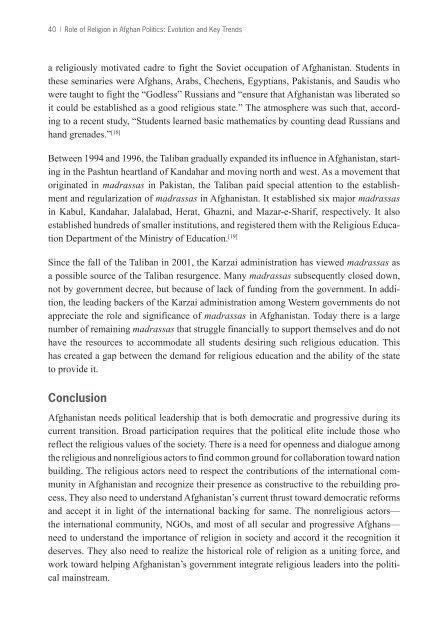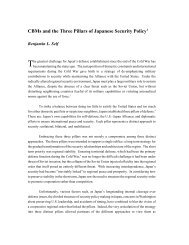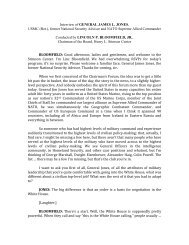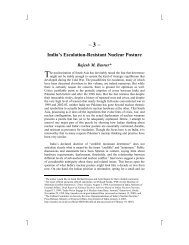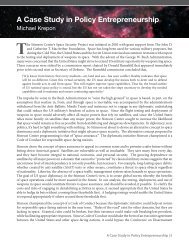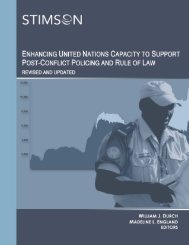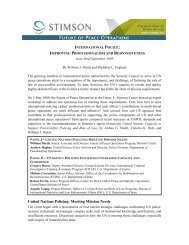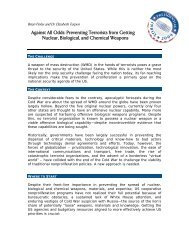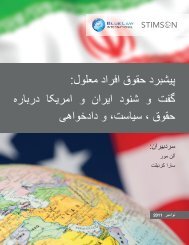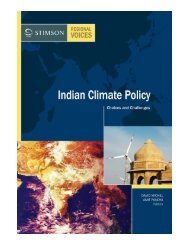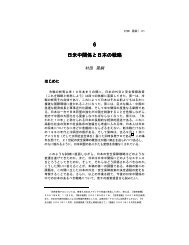Islam and Politics - The Stimson Center
Islam and Politics - The Stimson Center
Islam and Politics - The Stimson Center
Create successful ePaper yourself
Turn your PDF publications into a flip-book with our unique Google optimized e-Paper software.
40 | Role of Religion in Afghan <strong>Politics</strong>: Evolution <strong>and</strong> Key Trends<br />
a religiously motivated cadre to fight the Soviet occupation of Afghanistan. Students in<br />
these seminaries were Afghans, Arabs, Chechens, Egyptians, Pakistanis, <strong>and</strong> Saudis who<br />
were taught to fight the “Godless” Russians <strong>and</strong> “ensure that Afghanistan was liberated so<br />
it could be established as a good religious state.” <strong>The</strong> atmosphere was such that, according<br />
to a recent study, “Students learned basic mathematics by counting dead Russians <strong>and</strong><br />
h<strong>and</strong> grenades.” [18]<br />
Between 1994 <strong>and</strong> 1996, the Taliban gradually exp<strong>and</strong>ed its influence in Afghanistan, starting<br />
in the Pashtun heartl<strong>and</strong> of K<strong>and</strong>ahar <strong>and</strong> moving north <strong>and</strong> west. As a movement that<br />
originated in madrassas in Pakistan, the Taliban paid special attention to the establishment<br />
<strong>and</strong> regularization of madrassas in Afghanistan. It established six major madrassas<br />
in Kabul, K<strong>and</strong>ahar, Jalalabad, Herat, Ghazni, <strong>and</strong> Mazar-e-Sharif, respectively. It also<br />
established hundreds of smaller institutions, <strong>and</strong> registered them with the Religious Education<br />
Department of the Ministry of Education. [19]<br />
Since the fall of the Taliban in 2001, the Karzai administration has viewed madrassas as<br />
a possible source of the Taliban resurgence. Many madrassas subsequently closed down,<br />
not by government decree, but because of lack of funding from the government. In addition,<br />
the leading backers of the Karzai administration among Western governments do not<br />
appreciate the role <strong>and</strong> significance of madrassas in Afghanistan. Today there is a large<br />
number of remaining madrassas that struggle financially to support themselves <strong>and</strong> do not<br />
have the resources to accommodate all students desiring such religious education. This<br />
has created a gap between the dem<strong>and</strong> for religious education <strong>and</strong> the ability of the state<br />
to provide it.<br />
Conclusion<br />
Afghanistan needs political leadership that is both democratic <strong>and</strong> progressive during its<br />
current transition. Broad participation requires that the political elite include those who<br />
reflect the religious values of the society. <strong>The</strong>re is a need for openness <strong>and</strong> dialogue among<br />
the religious <strong>and</strong> nonreligious actors to find common ground for collaboration toward nation<br />
building. <strong>The</strong> religious actors need to respect the contributions of the international community<br />
in Afghanistan <strong>and</strong> recognize their presence as constructive to the rebuilding process.<br />
<strong>The</strong>y also need to underst<strong>and</strong> Afghanistan’s current thrust toward democratic reforms<br />
<strong>and</strong> accept it in light of the international backing for same. <strong>The</strong> nonreligious actors—<br />
the international community, NGOs, <strong>and</strong> most of all secular <strong>and</strong> progressive Afghans—<br />
need to underst<strong>and</strong> the importance of religion in society <strong>and</strong> accord it the recognition it<br />
deserves. <strong>The</strong>y also need to realize the historical role of religion as a uniting force, <strong>and</strong><br />
work toward helping Afghanistan’s government integrate religious leaders into the political<br />
mainstream.


